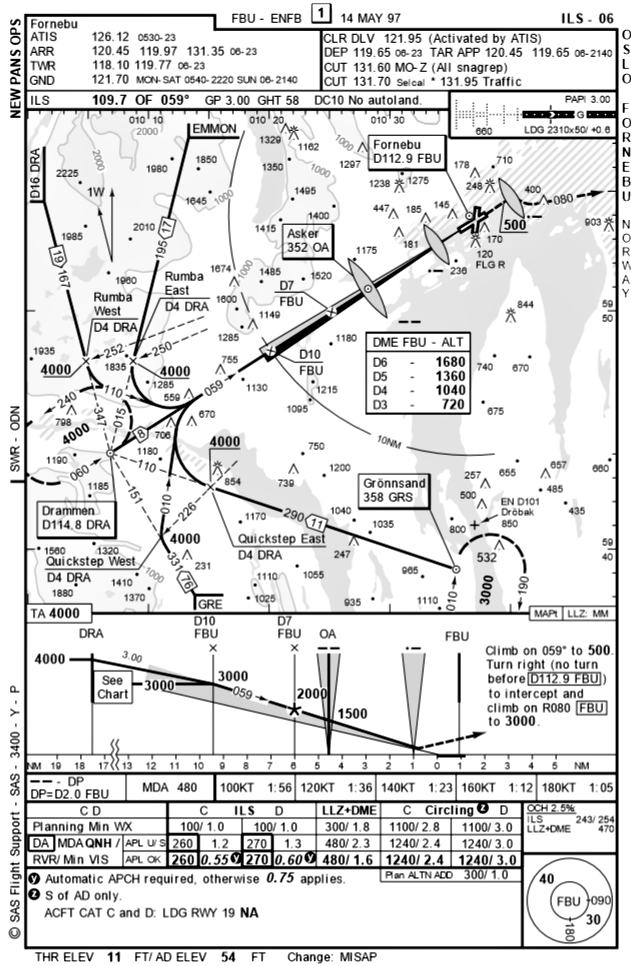Very eye opening video, thanks for posting.
And great reading the ensuing discussion.
EuroGA gold
I had some kind of deja vu seeing this approach, and sure enough, Oslo Fornebu (closed 1998) had almost exactly the same. We flew the ILS for rwy 06 with a “circle” to land rwy 01. Judging the circling visually was easy to do in the Bonanza, but to do that smoothly and safely in a much faster aircraft like the Learjet it would surely help having briefed about when to break off for the circling.

One of the advantages of training for the IR at Roskilde EKRK is that, because of nearby Copenhagen Kastrup, most instrument approaches are for rwy 11, while most landings are on other runways, very often 21. During training it was inevitable to fly many circling approaches for both the opposite direction and the two crossing directions.
Indeed a sad accident and a very good video. If the PIC had just admitted defeat during the circling instead of attempting the clearly impossible final turn, he could probably have survived another substandard performance flight. As an instructor, one could be tempted to show this to PPL students and other pilots who suddenly, to salvage a misjudged visual approach, bank much more during the turn to final, that they would ever do in normal flying. That is remarkably common.
the FAA refuses to chart it as such!
I thought it looked like a conventional, if not so common, type of circling. It is landing on a different runway from the runway to which the approach is flown, which is, more or less, the definition of a circling, and the point TORBY, where the circling maneuvre is supposed to begin, IS within the circling area, which extends 4,2 NM from the runway end for cat C aircraft (ICAO doc 8168). TORBY is closer than that. I don’t see any indication that it is a prescribed track procedure, only that there is a named waypoint to help pilots know when to start the maneuvre.
boscomantico wrote:
Any European IFR pilot knows the circlings can potentially be to any runway.
Exactly.
Airborne_Again wrote:
The most important issue is that what is called “circle to 1” is really not a circling procedure at all, rather a visual procedure with prescribed tracks but (according to code7700.com), the FAA refuses to chart it as such!
Nicely spotted! – here’s the reference to the actual approach: Link (scroll down)
“We call this a circling approach but it really isn’t, since you begin maneuvering well outside the circling approach area.”
RobertL18C wrote:
don’t all IR checkrides include a go around into a circle to land as part of the profile
Every sim course I have done in the US has included a circle to land, usually at night.
Indeed. Any angle above 30 degrees is a circling.
AdamFrisch wrote:
On parallel rwy approches they sometimes use the wording “sidestep to…”
‘Sidestep’ is a clearly defined maneuver when operating into parallel (and only parallel) runways:
ATC may authorize a standard instrument approach procedure, which serves either one of parallel runways that are separated by 1,200’ or less, followed by a straight-in landing on the adjacent runway
While it might have been more descriptive, it would have been the inappropriate instruction for the approach to be flown,
On parallel rwy approches they sometimes use the wording “sidestep to…”. I wonder if that would have been more visually descriptive in this scenario, even though they’re not parallel?
Many SOP’s prohibit circling approaches. I doubt any of the the airlines allow it. It’s just a sketchy maneuver at minimums. During sim training, it’s always the maneuver where you tend to screw up the most.
Mooney_Driver wrote:
Yea and how can you be qualified SIC on an airplane with pnf only? I don’t think that makes any sense at all. After all, there are two pilots supposed to fly this airplane, not a pilot and something difficult to define what his role was. SIC only implies to me that he is a fully qualified first officer, it is totally new to me that someone can sit in the RH seat without being allowed to actually fly the airplane. What in case of an incapacitation of the PIC?
AFAIU from a legal point of view, the SIC was allowed to fly the airplane. I.e. he had the necessary ratings etc. The decision to not let him be PF was made by the operator.
Dimme wrote:
Nothing I was taught. This was new for me.
I agree. If I didn’t know about the Teterboro procedure beforehand, I would have been just as confused. The idea that you can legally circle outside the circling area is completely new to me. It might very well be a US thing.